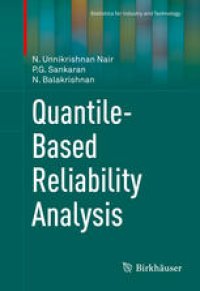
Ebook: Quantile-Based Reliability Analysis
- Genre: Technique // Mechanical Engineering
- Tags: Statistical Theory and Methods, Probability Theory and Stochastic Processes, Statistics for Engineering Physics Computer Science Chemistry and Earth Sciences, Statistics for Business/Economics/Mathematical Finance/Insurance, Statistics
- Series: Statistics for Industry and Technology
- Year: 2013
- Publisher: Birkhäuser Basel
- Edition: 1
- Language: English
- pdf
Quantile-Based Reliability Analysis presents a novel approach to reliability theory using quantile functions in contrast to the traditional approach based on distribution functions. Quantile functions and distribution functions are mathematically equivalent ways to define a probability distribution. However, quantile functions have several advantages over distribution functions. First, many data sets with non-elementary distribution functions can be modeled by quantile functions with simple forms. Second, most quantile functions approximate many of the standard models in reliability analysis quite well. Consequently, if physical conditions do not suggest a plausible model, an arbitrary quantile function will be a good first approximation. Finally, the inference procedures for quantile models need less information and are more robust to outliers.
Quantile-Based Reliability Analysis’s innovative methodology is laid out in a well-organized sequence of topics, including:
· Definitions and properties of reliability concepts in terms of quantile functions;
· Ageing concepts and their interrelationships;
· Total time on test transforms;
· L-moments of residual life;
· Score and tail exponent functions and relevant applications;
· Modeling problems and stochastic orders connecting quantile-based reliability functions.
An ideal text for advanced undergraduate and graduate courses in reliability and statistics, Quantile-Based Reliability Analysis also contains many unique topics for study and research in survival analysis, engineering, economics, and the medical sciences. In addition, its illuminating discussion of the general theory of quantile functions is germane to many contexts involving statistical analysis.
Quantile-Based Reliability Analysis presents a novel approach to reliability theory using quantile functions in contrast to the traditional approach based on distribution functions. Quantile functions and distribution functions are mathematically equivalent ways to define a probability distribution. However, quantile functions have several advantages over distribution functions. First, many data sets with non-elementary distribution functions can be modeled by quantile functions with simple forms. Second, most quantile functions approximate many of the standard models in reliability analysis quite well. Consequently, if physical conditions do not suggest a plausible model, an arbitrary quantile function will be a good first approximation. Finally, the inference procedures for quantile models need less information and are more robust to outliers.
Quantile-Based Reliability Analysis’s innovative methodology is laid out in a well-organized sequence of topics, including:
· Definitions and properties of reliability concepts in terms of quantile functions;
· Ageing concepts and their interrelationships;
· Total time on test transforms;
· L-moments of residual life;
· Score and tail exponent functions and relevant applications;
· Modeling problems and stochastic orders connecting quantile-based reliability functions.
An ideal text for advanced undergraduate and graduate courses in reliability and statistics, Quantile-Based Reliability Analysis also contains many unique topics for study and research in survival analysis, engineering, economics, and the medical sciences. In addition, its illuminating discussion of the general theory of quantile functions is germane to many contexts involving statistical analysis.
Quantile-Based Reliability Analysis presents a novel approach to reliability theory using quantile functions in contrast to the traditional approach based on distribution functions. Quantile functions and distribution functions are mathematically equivalent ways to define a probability distribution. However, quantile functions have several advantages over distribution functions. First, many data sets with non-elementary distribution functions can be modeled by quantile functions with simple forms. Second, most quantile functions approximate many of the standard models in reliability analysis quite well. Consequently, if physical conditions do not suggest a plausible model, an arbitrary quantile function will be a good first approximation. Finally, the inference procedures for quantile models need less information and are more robust to outliers.
Quantile-Based Reliability Analysis’s innovative methodology is laid out in a well-organized sequence of topics, including:
· Definitions and properties of reliability concepts in terms of quantile functions;
· Ageing concepts and their interrelationships;
· Total time on test transforms;
· L-moments of residual life;
· Score and tail exponent functions and relevant applications;
· Modeling problems and stochastic orders connecting quantile-based reliability functions.
An ideal text for advanced undergraduate and graduate courses in reliability and statistics, Quantile-Based Reliability Analysis also contains many unique topics for study and research in survival analysis, engineering, economics, and the medical sciences. In addition, its illuminating discussion of the general theory of quantile functions is germane to many contexts involving statistical analysis.
Content:
Front Matter....Pages i-xx
Quantile Functions....Pages 1-28
Quantile-Based Reliability Concepts....Pages 29-58
Quantile Function Models....Pages 59-103
Ageing Concepts....Pages 105-165
Total Time on Test Transforms....Pages 167-198
L-Moments of Residual Life and Partial Moments....Pages 199-233
Nonmonotone Hazard Quantile Functions....Pages 235-279
Stochastic Orders in Reliability....Pages 281-326
Estimation and Modelling....Pages 327-359
Back Matter....Pages 361-397